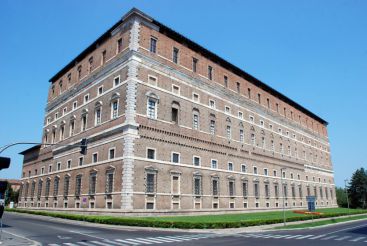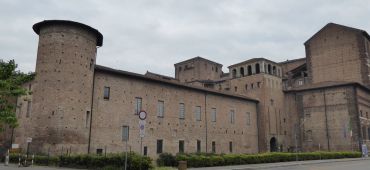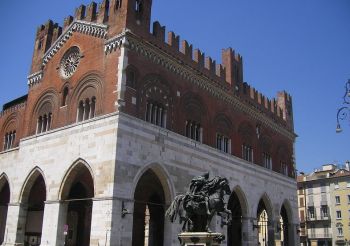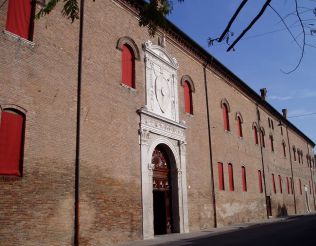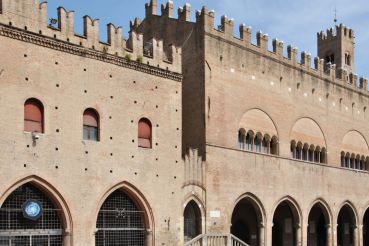Farnese Palace, Piacenza
Farnese Palace (Palazzo Farnese) is one of the largest attractions of Piacenza, an important architectural monument of the city. A huge palazzo houses the City Museum and the State Archives. The stern appearance contrasts with the magnificent interior of the noble residence. This building is the gem of the whole city.
History of the palace
In the Middle Ages, the Visconti fortress was built near the river in the northern part of the historic center of the city in 1352. In 1558, the first project for the construction of the palace appeared on the foundation of the former castle. It was designed by Francesco Paciotto at the request of the Duchess Margaret of Parma, the wife of Duke Ottavio Farnese. But the project was not approved, and a well-known architect, already creating palaces for the Farnese family, Giacomo Barozzi da Vignola, took up the work. His project dates back to 1561, and construction was completed only in 1602, after the death of the duchess. Due to lack of funds, the palace turned out to be half of the planned size. During the 17th century it was not expanded, but only adapted for the needs of subsequent rulers.
In the early 18th century, the last male representative of the family died, and the palace was passed to Charles III of Bourbon in 1731. Most of the paintings and other valuables were transported to Naples. In 1803, the mansion plundered the troops of Napoleon. In 1822 it was used as the barracks of the Austrian garrison, and during the Second World War – as a shelter for the homeless. In 1965, the Organization for the Restoration of the Palace of Farnese was established. In 1976 the complex became a municipal property, and in 1988 the first museum collections were opened here.
Palace
The great palace was to become a symbol of the power of the Farnese clan. The absence of a real façade gives the building an appearance of a stereometric block, the structure is very similar to other projects of Giacomo da Vignola. It has large diagonal niches, wide loggias and multiple arches. The real decoration is Farnese Fasti, which recreates the history of the Farnese family and the most significant members in various rooms of the palace, through paintings and frescoes on the walls. Great attention is paid to Pope Paul III, Cardinal Alessandro Farnese and the last representative of the family, Isabella Farnese.
Also on the ground floor there is a ducal chapel, which was not originally part of the Vignola project. This large octagonal room has double volumes and a harmonious sequence of flat and concave surfaces. A number of important events took place here in the 17th century, among them weddings and the baptism of heirs of the clan. Now the conference room is located in the restored building.
Museum
Inside the palazzo there are various collections of the City Civil Museum. The institution was among the first 5 museums in Europe and the first in Italy, using the technology of iBeacon. The exposition is very extensive and includes 10 sections, which differ thematically.
- Medieval frescoes. This was the first collection to open, back in 1988. It is located on all 6 floors of the palace, and includes images of the late Middle Ages from the churches of Piacenza. It is based on frescoes from the church of Santa Caterina.
- Archaeological collection. Here you can see finds from the region, from the time of the appearance of man, to the foundation of the Roman colony of Placentia in 218 BC. The pride of the collection is ancient ceramic vases and a collection of daggers, including bronze ones.
- Etruscan liver. It is one of the most prestigious finds, discovered in 1877. The bronze tablet has reliefs depicting the liver of sheep and inscriptions with the names of deities in the starry sky.
- Annals of the Farnese family. A series of paintings with the most significant representatives and events in the history of the family.
- Collection of weapons. It presents about 500 copies of ancient weapons collected in the 19th century by the counts of Parma. Later the collection was transferred to museums.
- Carriage. This collection is one of the biggest and most important in Italy. It was opened to visitors in 1998 and includes about 40 exhibits located in the basement of the palace. They are housed chronologically, dating back to 1700, and before the advent of vehicles. There are noble carriages, a fire-carriage, strollers, a sleigh, a Sicilian cart and even a hearse.
- Art Gallery. Paintings of the 14-19 centuries are collected in the Pinakothek collected, having a different origin: from churches, palaces and private collections.
- Sculptures. The museum features a series of sculptures reflecting the cultural life and development of Piacenza in the 12th and 14th centuries.
- Risorgimento. This part includes documents, images, weapons and other relics from the time of the War of Independence and the unification of Italy.
- Glass and ceramics. High-quality work, showing different styles throughout the 15-18 centuries.
Also the museum has a quality audio guide, which tells the history of the city in 12 sections.
How to get there
The palace and the museum are located in the historical center of Piacenza, on the Piazza della Cittadella, 29. A little to the north, near the bridge, there is the Monument to Bridge Builders, and in a 5-minute walk – the Gothico Palace. Near the palazzo, on the square, there is a bus station, which is the end stop of many routes. In a minute walk – stop Via Cavour, routes 1, 2, 6, 8, 9, 11, 15, 18, 19, CS go through it.
Opening hours: Tuesday, Wednesday, Thursday from 9:00 to 13:00, Friday and Saturday from 9:00 to 13:00 and from 15:00 to 18:00, Sunday from 9:30 to 13:00 and from 15:00 to 18:00. The ticket office closes 30 minutes earlier. The day off is Monday. Phone number: (+39) 0523 492658.
Admission: the price of a full ticket is 6 euros, with a discount (children (6-18), pensioners, groups) 3 euros. Fro children under 6 years and people with disabilities – free. Also there are free excursions from Friday to Sunday lasting 1.5 hours. Groups and free excursions require a reservation. Data of June 2018.



